|
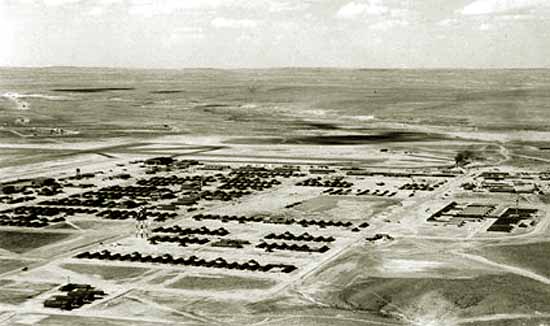
Casper Army-Air Corps Base, c. 1942.
With the end of the Oil Boom things again calmed down a bit in the Sand Bar, but with
World War II action in the Sand Bar increased. In 1942, the Casper Army-Air Corps Base opened nine miles west of town.
In the words of the old Wilf Carter song, it became the place for airmen to "Howl."
As the Denver Post's Robert Wesley "Red" Fenwick put it, keeping servicemen from the airbase away from the Sandbar was like
"trying to keep bees out of an alfalfa field when it is in bloom."
Although many of the cribs were razed in the 1920's, others remained until the
1970's. Tom Bishop described them in the sun
light as looking like "they were in pain and had smeared themselves in some kind of desperate healing rite."
Bishop, Tom: "The great Mormon cricket fly-fishing festival and other western stories," University of New Mex;ico Press, p. 76.
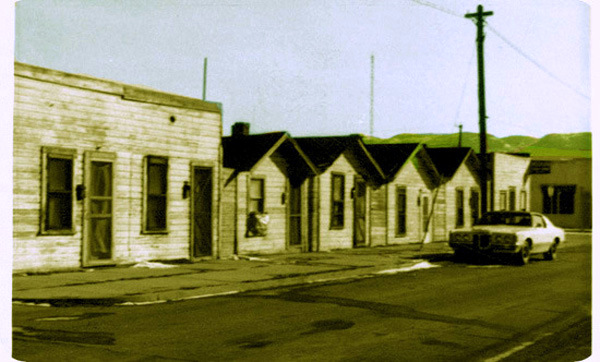
Abandoned cribs, Sandbar District, 1973.
In later years, behind the cribs were small backyards partially concealed from a dirt alley by an unpainted pallisade fence. Presumably
patrons could pull their vehicles into the small yards from the alley. They, therefore, did not need to park on the street where they could be
seen and also were able to partially hide their
presence from those using the alley.
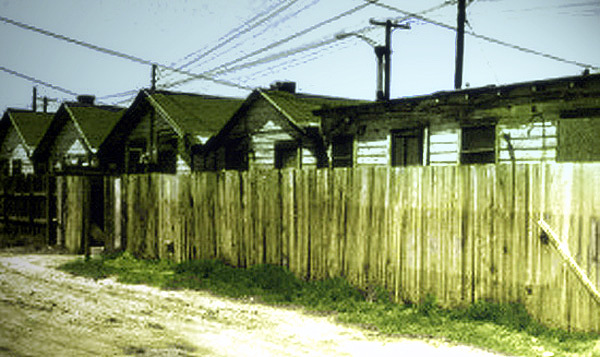
Abandoned cribs, Sandbar District, 1973.
The Sand Bar was described by lawyer Gerry Spence as a place where they sold
"bad whiskey and offered a variety of girls." See Spence, Gerry, Of Murder & Madness,
St. Martin's Paperbacks, 1995. The whiskey was served in coffee cups in case of a
police raid. It was not an area in which the timid should venture. Former County Prosecutor Raymond B.Whitaker, told Spence,
"They shoot people down on the Sand Bar in the daytime."
From the 1940's to about 1970, one
center of action in the Sand Bar was a two-story house, the "Van Rooms, located at 218 West B Street. The
Rooms were owned by Leo Weiss and operated by Fifi Belondon. Weiss also owned several cribs which he rented out for
$50.00 a month. When the City embarked on urban renewal a two-room crib owned by Weiss mysteriously disappeared.
The Star-Tribune, March 28, 1982, p. 95,
reported:
One day, he went over to look at it and it was gone. It simply had vanished overnight.
He said a friend, Kokomo Joe, witnessed the theft but thought nothing
of it. He thought It was an urban renewal Job. Kokomo Joe related that
some workmen with a flatbed, semi-trailer truck had simply backed up to
the house, jacked it up and carted it away. No trace of it has ever
been found.
By the early 1960's, The Van Rooms were, with what appeared to be a sagging
enclosed front porch, somewhat in
need of repair. Over the front door was a non-descript sign reading "VAN ROOMS" Later Johnny J's Diner featured a
neon sign with the same words. When then Senator Obama visited Casper, several photos were taken of him
beheath the Van Rooms neon sign. The writer has wondered whether he realized what the sign
denoted.
Fifi
Belondon was not the proprietress's real name of course. It is doubtful that
anyone knew her real name. It was changed on legal documents almost often as the sheets in her facility.
But to most she was known as Fifi. Miss Fifi had long black
hair and typically wore muumuus. Her companion Leo also worked at the railway depot. An adventure for high school
teenagers who had gotten a driver's license was to speed down
B street and honk their horns as they passed the cribs. In early 2016 the Fort Caspar Museum
displayed a water color painting of the outside of Miss Fifi's establishment.>/p>
There may have been legitimate reasons to visit the Sand Bar. One might go to
Fanny Bells for the fried chicken. It was in the days when fried chicken was a big treat,
in the days before chicken was produced in giant
chicken factories and Harland Sanders discovered a method of quickly producing fried chicken by deep frying it after it had
been cooked in a pressure cooker. Mr. Nick (Nick Maragos 1890-1972) a grocer noted for his generosity and patriotism started his
grocery in the Sand Bar. Ultimatelly, he had, however, to move his grocery. he was remembered by one friend,
"He was really a patriotic guy. If we had a lot of
Mr. Nicks, this country would be jn a lot better shape especially today.
You couldn't say anything bad to him about the United States.
He was a good soldier he was a good everything."
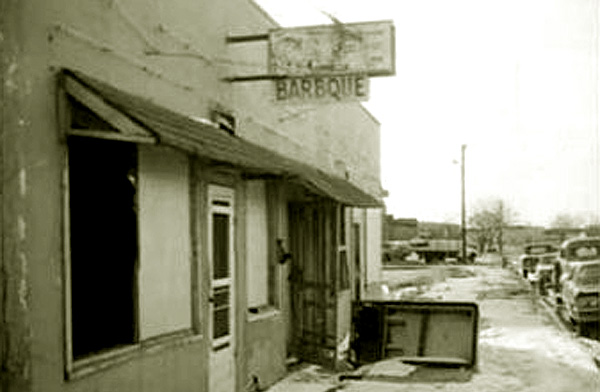
Abandoned "barbque" stand, 1973. Note the spelling on the sign.
Next door to an establishment known as "Mexican Mary's on West B Street was another barbecue using the same spelling.
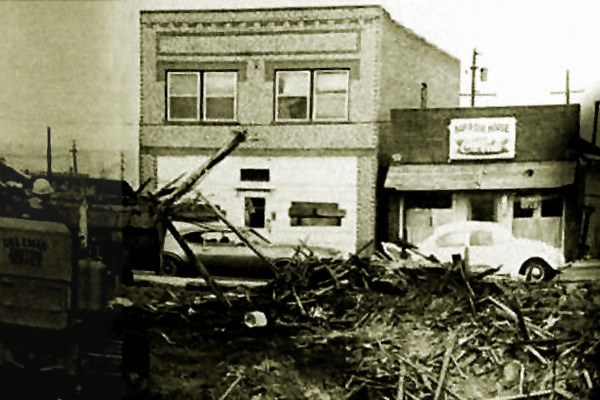
On the left is the boarded-up Mexican Mary's. To its right is the barbecue stand. The demolition
in the foreground are the remains of the Southern Plantation being removed, 1972.
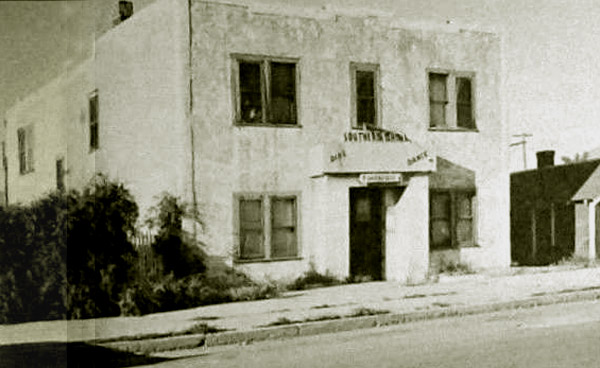
The Southern Mansion prior to its demolition.
Note temporary sign below the upstairs center window announcing that it was closed, also the notice posted on the door.
The Southern Mansion as indicated by the signs was ostensibly a dance hall. It also had "rooms."
Clive Scott Chisholm in his "Following the Wrong God Home," University of Nebraska Press, 2009, p. 270,
referred to both it and the Palace
Hotel located at 241 West B Street as "legendary outposts of vice."
In the 1960's the city attempted a crackdown. Miss Fifi's establishment was raided
some 130 times and $13,000 in fines levied. At one point, the municipal judge Frank Bowron offered to suspend one fine if Miss Fifi would just leave town.
She declined the offer.
But the City meant business and finally three convictions were deemed to merit jail. They were appealed to the
District Court and from the District Court to the Wyoming Supreme Court. Thence the cases were taken to the
United States Supreme Court. See Belondon v. City of Casper, 456 P. 2d 218 (Wyo. 1969), cert. den.
398 U.S. 927. For details of the City's legal efforts to close the Van Rooms see also 456 P. 2d. 230; 379 P. 2d 828; 434 P. 2d 761; 435 P. 2d 280; 455 P. 2d 904).
Miss Fifi's establishment was ultimately torn down as part of urban renewal. Leo Weiss acquired another
house on W. Park Street which he later contended was used for legitimate rental of rooms. The Star-Tribune March 28, 1982 p. 95 explained:
Just for old-times' sake he has equipped the lobby of the new rooming house
with a Jukebox and some sofas. He says, "No, there's no action here. We
ust rent rooms. "
Other sightly buildings were dismantled.
The area where the Palace, Mexican Mary's, some of the cribs, and the Van Rooms were located is now
occuppied by the City Hall, an old folks home, lawyers, and parking. Knowlingly renting rooms to persons who sublet to damsels
of the evening is now a violation of a Casper city ordinance.
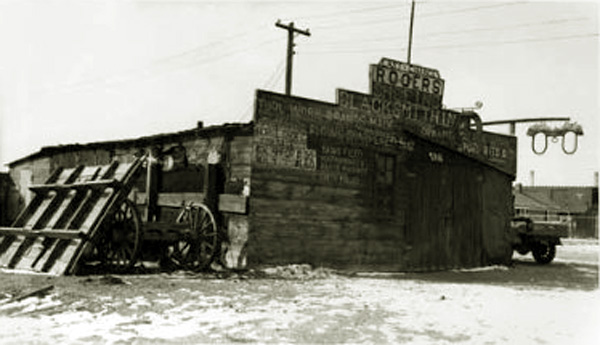
Abandoned blacksmithy, 1973.
Music this Page: "It's My Night to Howl" as performed by Montana slim."
Next page: Casper continued.
|